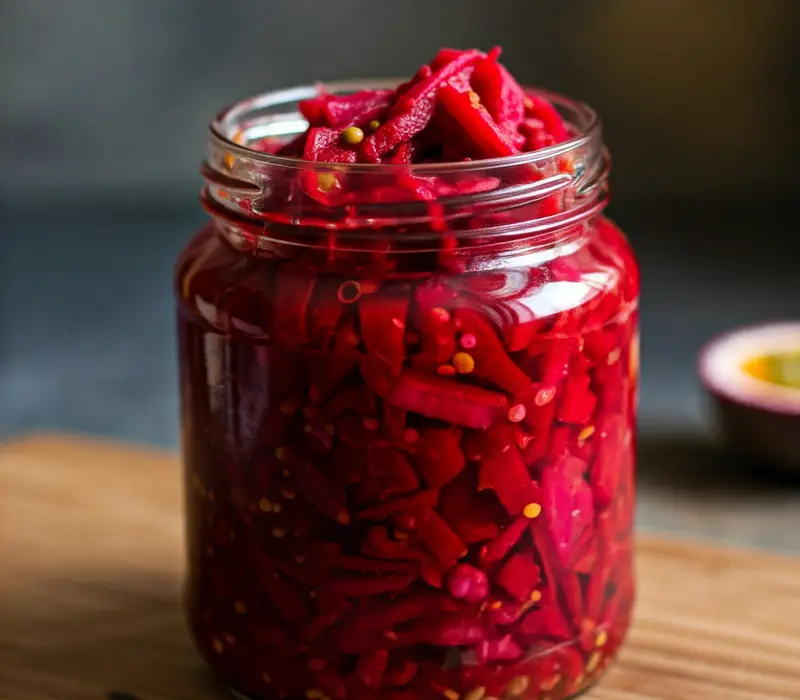Iraqi Red Pickle (Torshi)

Iraqi cuisine is famous for its flavorful pickles, or torshi, served as a side dish to complement hearty meals. One of the most popular variations is the red pickle, made with a vibrant mix of beets, turnips, carrots, cauliflower, and white radish (hana). This pickle not only adds a pop of color to meals but also brings a distinctive tangy and slightly spiced flavor.
Preparation steps, and tips to make Iraqi red pickle using traditional techniques. Visitors to Iraq will find torshi served with many dishes, including kebabs, falafel, and grilled fish. With its authentic ingredients and method, this recipe is a cultural experience worth trying.
Ingredients for Iraqi Red Pickle
To make authentic Iraqi red pickle, you’ll need the following ingredients:
Beets (Shamandar) – Adds deep red color and sweetness.
Turnips (Shalgham) – Provides a crunchy texture.
Carrots – For sweetness and crunch.
Cauliflower (Qarnabit) – Adds body to the pickle mix.
White radish (Hana) – Helps balance the flavors with mild sharpness.
Coarse salt – Essential for fermentation and flavor.
White vinegar – Adds acidity to the pickle.
Pickling spices:
Black pepper
Coriander
Cubeb pepper (kababa)
Cumin
Turmeric
Red pepper flakes
A pinch of salt
Step-by-Step Preparation of Iraqi Red Pickle
1. Preparing the Vegetables
Washing: Thoroughly rinse the beets, turnips, and radish to remove any dirt. A helpful tip for cleaning turnips is to rub them with coarse salt and rinse them under water to reduce their strong odor.
Removing moisture: Repeat the cleaning process with the radish and cauliflower to remove excess moisture and any lingering smells.
2. Cutting the Vegetables
Slicing the beets, turnips, and carrots: Cut them into thick slices to prevent them from becoming mushy during the pickling process.
Chopping cauliflower and white radish: Cut into manageable pieces, ensuring they maintain their texture when pickled.
Optional Step – Parboiling the beets: Boil the beets for 10 minutes to soften them slightly. This step prevents them from becoming overly soft during fermentation and helps release their red pigment, which adds color to the pickle brine.
Layering and Filling the Jar
3. Choosing a Proper Container
Use an airtight glass jar for the best results. If unavailable, a plastic jar will work, but glass is preferred for better preservation of flavors.
4. Arranging the Vegetables
Begin by layering the beets, turnips, carrots, radish, and cauliflower in the jar. Make sure to press the vegetables down slightly to eliminate air pockets, which could interfere with fermentation.
5. Preparing the Brine
Combine the reserved beet water, white vinegar, and coarse salt. Mix until the salt dissolves completely. Add the pickling spices (black pepper, coriander, cubeb pepper, cumin, turmeric, red pepper) to the mixture.
Fill the jar with brine: Pour the prepared brine into the jar, ensuring the liquid covers the vegetables completely. Leave a small space below the jar’s lid to allow for expansion.
Key Tips for Successful Fermentation
1. Seal the Jar Properly
Ensure the jar is tightly sealed to prevent contamination and spoilage. Using an airtight lid is essential to keep the pickle fresh.
2. Store in a Warm, Dry Place
Place the jar in a room-temperature environment, ideally away from direct sunlight. A temperature range of 20-25°C (68-77°F) is ideal for proper fermentation.
3. Fermentation Time
Allow the pickle to ferment for 7 to 10 days. During this period, the flavors will intensify, and the vegetables will soften slightly while retaining their crunch.
4. Check for Spoilage
Ensure the vegetables remain submerged in the brine throughout the fermentation process. If the liquid level drops, top it off with more vinegar or salted water to prevent mold growth.
Serving Iraqi Red Pickle
Iraqi red pickle is versatile and can accompany a variety of dishes. Travelers in Iraq will notice it served with meals such as:
Grilled meat and kebabs – The tangy pickle balances the richness of grilled dishes.
Falafel sandwiches – A few pieces of torshi add a burst of flavor and texture.
Rice and stew dishes – Pickles provide a contrasting element to hearty rice meals like quzi or biryani.
Seafood platters – Fish dishes often benefit from the tart and spiced notes of torshi.
The vibrant red color of this pickle also makes it visually appealing, making it a centerpiece at Iraqi dining tables.
Health Benefits of Fermented Pickles
Beyond their taste, fermented pickles like torshi provide several health benefits:
Rich in probiotics: Fermentation introduces beneficial bacteria that support gut health.
Improved digestion: The vinegar and spices in torshi aid digestion, particularly when paired with heavier foods.
Vitamin boost: Vegetables retain many of their nutrients during fermentation, including fiber, vitamins C, and K.
Low-calorie side dish: Pickles offer a flavorful, low-calorie addition to meals.
Storing the Pickle After Fermentation
After the 7-10 day fermentation period, transfer the jar to the refrigerator to slow down further fermentation. Properly stored, the pickle can last for several months. The flavors will continue to develop over time, making the pickle even more delicious as it ages.